Papers by Giulia Muti

Levant, 2024
Discoid loom weights are a distinctive type of weaving tool widely found at Bronze Age sites acro... more Discoid loom weights are a distinctive type of weaving tool widely found at Bronze Age sites across
the Aegean region. The identification of these artefacts in the Cypriot record sheds new light on the
contacts between the island and the Aegean at the dawn of the Late Bronze Age. This paper aims
to analyse the earliest examples of Cypriot discoid loom weights, retrieved from early Late Bronze
Age contexts at Kalopsidha and Enkomi. The study focuses on their function and implications
concerning the adoption of new weaving tools and likely practices within a period of profound
social and economic transformations on the island. While transfers of technologies and
practices to Cyprus are largely hypothesized for the various changes reflected in the material
culture of this period, the transmission dynamics remain largely unknown. Therefore, discoid
loom weights provide us with a new perspective from which to examine the mechanisms of the
spread of tools and practical knowledge to the island during this crucial period.
Near Eastern Archaeology 85(1), 2022
This article argues that a renewed analysis of textile manufacture can bring a fresh perspective ... more This article argues that a renewed analysis of textile manufacture can bring a fresh perspective to approach the cultural transformations occurring in Cyprus during the mid-third millennium BCE and to investigate their significance. I present the main interpretations on the transition from the Chalcolithic to the Bronze Age as indicated by current archaeological research and explain the value of textile tools as archaeological indicators. Following this, the available data for selected textile activities (fiber exploitation and thread-making) are analyzed and discussed. The final aim is to demonstrate how current narratives can be challenged when technology is not the only aspect considered, and productive purposes and raw materials are also included.

S. Aulsebrook, K. Żebrowska, A. Ulanowska and K. Lewartowski eds, Sympozjum Egejskie. Papers in Aegean Archaeology 3 , 2022
This paper aims to investigate on the environment of textile production in the Kouris valley (Lim... more This paper aims to investigate on the environment of textile production in the Kouris valley (Limassol district, Cyprus) between the Early Bronze Age and Late Bronze Age IA (EBA–LBA IA, c.2200–1400 BCE). Specifically, it intends to explore the relationship between the textile assemblages of three selected sites and their landscape, to shed more light on the procurement and management of natural resources employed in the valley’s textile production, and to understand the socio-economic importance of this manufacture. After having reflected on the diachronic development of textile manufacture in a topographically distinct area, this article attempts to move beyond the craft–landscape relationship and towards a conceptualisation of textile work as the co-interaction of humans, landscape, tools, structures, diverse raw materials and resources; thus, constituting a ‘textile environment’.
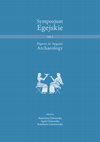
SYMPOZJUM EGEJSKIE II. Papers in Aegean Archaeology (2019). Eds. K. Żebrowska, A. Ulanowska, and K. Lewartowski, 2019
Spindle whorls are amongst the small objects most frequently recovered from Early and Middle Bron... more Spindle whorls are amongst the small objects most frequently recovered from Early and Middle Bronze Age cemeteries in Cyprus ( c. 2400–1650 BC ). Nonetheless, little has been done to investigate their meaning. This paper will explore the symbolism of spindle whorls and its possible implications for the construction of the deceased’ s identity. In particular, we will discuss the concept of whorls as sex /gender markers, and how and to what extent these artefacts may have played a role in the ideological
system of Early /Middle Cypriot society alluding to aspects of the personal, social, and group identities of the deceased. To do this, the investigation will follow a case-study design in which select burial contexts from the Early and Middle Cypriot sites of Erimi Laonin tou Porakou, Lapithos Vrysi tou Barba, and Galinoporni will be included. The analysis of different key elements related to the whorls’ deposition within the tombs examined ( e.g. formal characteristics, evidence for use-wear, location, relationship with bodies, and association occurrences ) and the identification of recurring patterns will facilitate a discussion on the reasons behind the transformation of these tools into grave goods.
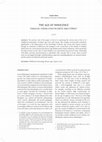
Żebrowska K., Ulanowska A., and Lewartowski K. (eds.), Sympozjum Egejskie: Papers in Aegean Archaeology. Volume I, 2017
The primary aim of this paper is to preliminarily re-examine the current state of the art of ‘Chi... more The primary aim of this paper is to preliminarily re-examine the current state of the art of ‘Childhood Archaeology’ in Bronze Age Crete and Cyprus. This complex research field contributes significantly to improve our knowledge of Bronze Age Cretan and Cypriot societies, in order to evaluate differences and analogies in constructing the identity of children within two coeval and peculiar Bronze Age Mediterranean island societies. In particular, this paper focuses on the ways in which children were represented and perceived, their relationship with adults, and their characterization as individuals with a specific role in society. These issues are investigated through a multidisciplinary approach, including visual records and iconography, material culture and human remains.
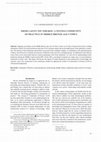
FASCICULI ARCHAEOLOGIAE HISTORICAE XXXI, 2018
Ongoing excavations at the Middle Bronze Age site of Erimi Laonin tou Porakou (Cyprus) have been ... more Ongoing excavations at the Middle Bronze Age site of Erimi Laonin tou Porakou (Cyprus) have been revealing substantial evidence for textile production and clues of its economic impact and social implications to this prehistoric community. The analysis of the architecture and artefacts recovered in the workshop complex, in combination with archaeobotanical evidence, has allowed us to identify the presence of different textile activities, including dyeing. An additional textile data-set comes from coeval extramural funerary contexts pertaining to the Erimi settlement. As a key-site for understanding textile production during the Middle Cypriot period (MC), Erimi offers a privileged viewpoint on a large array of social dynamics connected to textile work. This paper will discuss the impact of textile production in the transmission of knowledge and expertise, and in the construction of the community mindset by applying the model of Communities of Practice (CoP) as a theoretical background.
Ancient Cyprus, an Unexpected Journey. Communities in Continuity and Transition, Eds. L. Bombardieri, M. Amadio, and F. Dolcetti., 2017
This paper aims to investigate the productive, economic, and social aspects of textile dyeing in ... more This paper aims to investigate the productive, economic, and social aspects of textile dyeing in Bronze Age Cyprus. Archaeological evidence for this activity is discussed through the analysis of the most informative case studies of different periods, with the purpose of detecting which raw materials and techniques were employed, and which colours were obtained. The focus then passes to the investigation of the possible high value of dyed textiles as prestige and/or exchanging goods. In addition, the social importance of textile dyeing as a working activity to Middle and Late Cypriot communities will be highlighted.
Bombardieri, L., and Panero E. (eds.), Cipro Crocevia delle Civiltà - Catalogo della Mostra/Cyprus Crossroad of Civilizations – Exhibition Catalogue, 2021
Part of the chapter: Romani, S., Muti, G., and Pettiti, P. (2021), Il ruolo della donna e l’immag... more Part of the chapter: Romani, S., Muti, G., and Pettiti, P. (2021), Il ruolo della donna e l’immaginario femminile nell’isola di Afrodite/The role of women and the female imaginary on the island of Aphrodite, in: Bombardieri, L., and Panero E. (eds.), Cipro Crocevia delle Civiltà - Catalogo della Mostra/Cyprus Crossroad of Civilizations – Exhibition Catalogue. Rome: De Angelis Editore, pp. 133–146.
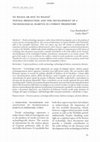
Origini XLI, 2018-1, 2019
Textile archaeology represents a rather elusive field of investigation, just as the products of t... more Textile archaeology represents a rather elusive field of investigation, just as the products of textile activities archaeologically are. The scarcity of information on Cypriot Neolithic and Chalcolithic adds to this inevitable elusiveness. These two aspects may have led scholars to underestimate the importance of the few available pre-BA documents, which, however, suggest an initial textile production as early as the Neolithic. Additionally, besides shedding some light on a regional aspect of the history of technology, these documents may provide a valuable contribution to the wider debate on the character and development of the technological habitus of prehistoric communities in an insular context. The goal of this study is to try to delineate the evidence related to textile production in pre-BA contexts. Towards this end, it is necessary to examine different textile markers relevant to primary (textile tools and products) and secondary (raw materials and iconography) evidence.
D. Glörfeld, K. Kittig, B. Morstadt, and C. von Rüden (eds.),The Many Face(t)s of Cyprus 14th Meeting of Postgraduate Cypriot Archaeology, 2019
Terracotta a spindle whorl assemblages are widely attested in Early (EC) and Middle Bronze Age (M... more Terracotta a spindle whorl assemblages are widely attested in Early (EC) and Middle Bronze Age (MC)
Cyprus. Since their introduction at the very beginning of the Bronze Age (Philia period), they appear
in different functional contexts, i.e. settlements and cemeteries. The significant occurrence in domestic
and working areas has been straightforwardly related to the important role they played in textile
production. At the same time, they were charged with symbolic value when buried as grave goods.
The aim of this study is that of identifying possible symbolic meanings of spindle whorls from EC–MC
burial contexts, focusing on case studies from the South Coast.
Book Chapters by Giulia Muti
Islands in Dialogue (ISLANDIA) Proceedings of the First International Postgraduate Conference in the Prehistory and Protohistory of the Mediterranean Islands: 11 19. Roma: Artemide Edizioni., 2021
Books by Giulia Muti
Proceedings of the First International Postgraduate Conference in the Prehistory and Protohistory... more Proceedings of the First International Postgraduate Conference in the Prehistory and Protohistory of the Mediterranean Islands
by Luca Bombardieri, Marialucia Amadio, Caterina Scirè Calabrisotto, Jennifer Webb, Mari Yamasaki, Grazia Tucci, Giulia Muti, Francesca Dolcetti, Martina Monaco, Erika Albertini, and Elena Vassio with contributions by Erika Albertini, Marialucia Amadio, Valentina Bonora, Alessandro Conti, Giu... more with contributions by Erika Albertini, Marialucia Amadio, Valentina Bonora, Alessandro Conti, Giulia Dionisio, Francesca Dolcetti, Mariaelena Fedi, Marco Fioravanti, Lidia Fiorini, Martina Fissore, Peter Gasson, Carole McCartney, Martina Monaco, Giulia Muti, Daniele Redamante, David S. Reese, Alessanda Saggio, Caterina Scirè Calabrisotto, Grazia Tucci, Elena Vassio, Jennifer M. Webb and Mari Yamasaki
Book Reviews by Giulia Muti
Topoi 22/1, 2019
Review of Leila Badre, Emmanuelle Capet and Barbara Vitale, Tell Kazel au Bronze Récent. Études c... more Review of Leila Badre, Emmanuelle Capet and Barbara Vitale, Tell Kazel au Bronze Récent. Études céramiques, Bibliothèque archéologique et historique 211, Beyrouth, Presses de l’Ifpo, 2018. Topoi 22/1, pp. 685–688.
Medioevo Greco (MEG), 2018
MEG Medioevo Greco , 2017
Talks by Giulia Muti

SYMPOZJUM EGEJSKIE 7th Conference in Aegean Archaeology, 6-7 June 2019, Warsaw, Poland, 2019
Being the largest river basin and among the richest hydrogeological areas in Cyprus, the Kouris V... more Being the largest river basin and among the richest hydrogeological areas in Cyprus, the Kouris Valley (Limassol district) has played a strategic role in relation to natural resources for past and present communities. In terms of excavated settlement sites, the valley shows one of the best-established sequences throughout the Bronze Age. Also, the majority of the Kouris Valley sites have yielded substantial evidence for textile manufacture, documented both at a domestic and workshop level, which makes the area unique to investigate this production.
This paper aims to explore the relationship between textile production and its environment, namely the procurement and management of natural resources employed in each identified step of the chaîne opératoire.
The final goal will be to define the diachronic development of neighbour sites located within a topographically-distinct area. Because this study represents an entering point to this investigation, we will focus on three pilot case studies (Sotira Kaminudhia, Erimi Laonin tou Porakou, Episkopi Phaneromeni), showing an occupation which ranges from the Early Cypriot I to the Late Cypriot IA (ca 2400–1550 BC).
The complexity of textile work(s), requiring both expert human skills, a multiplicity of different raw materials and natural resources, and suitable spaces, will be used as a privileged focus facilitating a more complex
analysis of the ancient environment. The Kouris Valley will not be a mere geographical background, but both an essential component and the context of textile production shedding new light on the development of work strategies, production goals, and community networks.
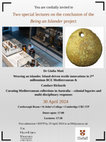
Castlereagh Room • St John’s College • Cambridge, 2024
This lecture explores the capacity of islands to absorb, adapt, transform, and echo material cult... more This lecture explores the capacity of islands to absorb, adapt, transform, and echo material culture, technologies, social and economic trajectories, and many other key aspects of life (and death) with which they come in contact. The perspective adopted here is that of textile production, and it proposes a reflection upon the substantial contribution of island communities in the transmission of weaving technologies and
practices related to the spread of discoid loom weights in the eastern Mediterranean during the Late Bronze Age (c. 1700/1600–1200/1100 BCE). This type of loom weights originated in Crete, one of the key islands
in the ‘Being and Islander’ project and exhibition and spread out primarily to islands and coastal sites of the Aegean region, suggesting female mobility and the sea as the social and physical vectors through which
technological exchange and practice transmission were travelling.
It was not until very recently that the presence of such Aegean-inspired tools was identified in Cyprus, another case study investigated by the ‘Being an Islander’ project. The island of copper and Aphrodite represents a new angle into the phenomenon and provides a unique opportunity to look not only at its beginnings —namely, how the Cypriot weavers acquired and engaged with Aegean-inspired textile tools— but also at its
internal developments and aftermaths, once again, out of the island. These weaving tools became one of the most widespread classes of loom weights in Cyprus throughout the Late Bronze Age, even when
they started decreasing in popularity in the Aegean. Moreover, Cyprus seems to have played a significant role in their further spread to coastal centres of the Levant, such as Ugarit and Alalakh. The multifaceted, multi-step nature of this spread is part of and transcends ‘Minoanisation’, a concept used to describe the transmission of Cretan material culture, style and practices throughout and beyond the Aegean. By touching upon relationships between discoid weights and other materials, such as ceramic and metal objects, the dynamics of Aegean-Cypriot-Levantine networks are elucidated. Even though the primary focus is on the role of islands in the spread of discoid loom weights, the topic also allows us to reflect upon other agents (e.g., women, textile practitioners), both incorporating the ‘usual suspects’ in the discussion and moving beyond them.
CAARI LECTURE PROGRAMME, 2022
AVAILABLE AT: https://www.youtube.com/watch?v=OpGmqFrn4Bc

The Levantine Ceramics Project. LCP Workshops Series.Ceramic Wares of Cyprus from Neolithic through Medieval times (CAARI, Nicosia, 13th-14th June 2019)
My presentation focused on a specific functional category, the storage vessels (pithoi and large ... more My presentation focused on a specific functional category, the storage vessels (pithoi and large jars) from the so-called ‘workshop complex’ at Erimi Laonin tou Porakou. Erimi is a Middle Cypriot (ca 2000–1650 BC) site located on a plateau on the eastern bank of the river Kouris, in South Coast Cyprus.
Pithoi are a suitable example to illustrate the main ware classes identified at Erimi (namely, local Red Polished, Drab polished, and Plain White wares) and their characteristics. So far, a total of 40 complete or fragmentary pithoi and large jars have been recognised from the two main occupational phases of the workshop. The majority come from the roofed units of the latest period of occupation. Each identified class was described in tandem with the illustration of the diagnostic traits of these vessels (e.g. the shape of body parts, decoration).
Having defined the Erimi pithoi and storage jars, I reflected upon the function of these large vessels in the second part of my presentation. Pithoi play a crucial role in recent research on the late MC and the definition of the transitional period MCIII/LCIA as it has often noted in the literature that this category grows in importance in this period. In particular, they are connected to an increase in storage capacity.
At first glance, the Erimi workshop seems the perfect example of storage intensification and the exploitation of communal spaces for this purpose. Therefore, my research questions were the followings:
1) Are all the Erimi storage vessels actually/only used for storage? In other words, what is the role of contexts in the definition of their function?
2) Which types of storage practices can we reconstruct these vessels in their contexts?
Stratigraphy and micromorphology indicate that the Erimi workshop was intentionally abandoned. Concerning intact or nearly complete vessels from the most recent occupational phase, their distribution is of one to three elements per room. The concertation and capacity are thus high, but they appear as equally disseminated in all the inner spaces, along with work installations, other vessels and tools. There are no cases of pithos concentrations in single rooms or rooms with assemblages exclusively dominated by storage vessels: none of these spaces can thus be defined as an organised storage area at Erimi.
Basing on the analysis of pithoi in their contexts, I identified and illustrated three different cases illuminating the storage practices and significance of pithoi at Erimi:
1) Pithoi in direct association with working installations or employed in specific working activities (including their possible use as dyeing vats, as textile manufacture seems to have played an important role in the workshop).
2) Pithoi/large jars from concentrations of vessels and other artefacts.
3) Storage vessels in special contexts (including ritual/sacred).
Upon analysis, the function of these large vessels appeared thus more fluid than thought by labelling them into functional categories and does not depend exclusively on the form but also on contexts and associations.
The Erimi storage vessels facilitated an introduction to the main wares present at Erimi and contributed to shed new light on the role of storage vessels in MC community spaces.
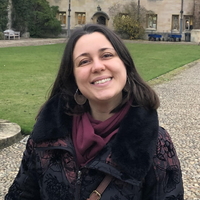
Uploads
Papers by Giulia Muti
the Aegean region. The identification of these artefacts in the Cypriot record sheds new light on the
contacts between the island and the Aegean at the dawn of the Late Bronze Age. This paper aims
to analyse the earliest examples of Cypriot discoid loom weights, retrieved from early Late Bronze
Age contexts at Kalopsidha and Enkomi. The study focuses on their function and implications
concerning the adoption of new weaving tools and likely practices within a period of profound
social and economic transformations on the island. While transfers of technologies and
practices to Cyprus are largely hypothesized for the various changes reflected in the material
culture of this period, the transmission dynamics remain largely unknown. Therefore, discoid
loom weights provide us with a new perspective from which to examine the mechanisms of the
spread of tools and practical knowledge to the island during this crucial period.
system of Early /Middle Cypriot society alluding to aspects of the personal, social, and group identities of the deceased. To do this, the investigation will follow a case-study design in which select burial contexts from the Early and Middle Cypriot sites of Erimi Laonin tou Porakou, Lapithos Vrysi tou Barba, and Galinoporni will be included. The analysis of different key elements related to the whorls’ deposition within the tombs examined ( e.g. formal characteristics, evidence for use-wear, location, relationship with bodies, and association occurrences ) and the identification of recurring patterns will facilitate a discussion on the reasons behind the transformation of these tools into grave goods.
Cyprus. Since their introduction at the very beginning of the Bronze Age (Philia period), they appear
in different functional contexts, i.e. settlements and cemeteries. The significant occurrence in domestic
and working areas has been straightforwardly related to the important role they played in textile
production. At the same time, they were charged with symbolic value when buried as grave goods.
The aim of this study is that of identifying possible symbolic meanings of spindle whorls from EC–MC
burial contexts, focusing on case studies from the South Coast.
Book Chapters by Giulia Muti
Books by Giulia Muti
Book Reviews by Giulia Muti
Talks by Giulia Muti
This paper aims to explore the relationship between textile production and its environment, namely the procurement and management of natural resources employed in each identified step of the chaîne opératoire.
The final goal will be to define the diachronic development of neighbour sites located within a topographically-distinct area. Because this study represents an entering point to this investigation, we will focus on three pilot case studies (Sotira Kaminudhia, Erimi Laonin tou Porakou, Episkopi Phaneromeni), showing an occupation which ranges from the Early Cypriot I to the Late Cypriot IA (ca 2400–1550 BC).
The complexity of textile work(s), requiring both expert human skills, a multiplicity of different raw materials and natural resources, and suitable spaces, will be used as a privileged focus facilitating a more complex
analysis of the ancient environment. The Kouris Valley will not be a mere geographical background, but both an essential component and the context of textile production shedding new light on the development of work strategies, production goals, and community networks.
practices related to the spread of discoid loom weights in the eastern Mediterranean during the Late Bronze Age (c. 1700/1600–1200/1100 BCE). This type of loom weights originated in Crete, one of the key islands
in the ‘Being and Islander’ project and exhibition and spread out primarily to islands and coastal sites of the Aegean region, suggesting female mobility and the sea as the social and physical vectors through which
technological exchange and practice transmission were travelling.
It was not until very recently that the presence of such Aegean-inspired tools was identified in Cyprus, another case study investigated by the ‘Being an Islander’ project. The island of copper and Aphrodite represents a new angle into the phenomenon and provides a unique opportunity to look not only at its beginnings —namely, how the Cypriot weavers acquired and engaged with Aegean-inspired textile tools— but also at its
internal developments and aftermaths, once again, out of the island. These weaving tools became one of the most widespread classes of loom weights in Cyprus throughout the Late Bronze Age, even when
they started decreasing in popularity in the Aegean. Moreover, Cyprus seems to have played a significant role in their further spread to coastal centres of the Levant, such as Ugarit and Alalakh. The multifaceted, multi-step nature of this spread is part of and transcends ‘Minoanisation’, a concept used to describe the transmission of Cretan material culture, style and practices throughout and beyond the Aegean. By touching upon relationships between discoid weights and other materials, such as ceramic and metal objects, the dynamics of Aegean-Cypriot-Levantine networks are elucidated. Even though the primary focus is on the role of islands in the spread of discoid loom weights, the topic also allows us to reflect upon other agents (e.g., women, textile practitioners), both incorporating the ‘usual suspects’ in the discussion and moving beyond them.
Pithoi are a suitable example to illustrate the main ware classes identified at Erimi (namely, local Red Polished, Drab polished, and Plain White wares) and their characteristics. So far, a total of 40 complete or fragmentary pithoi and large jars have been recognised from the two main occupational phases of the workshop. The majority come from the roofed units of the latest period of occupation. Each identified class was described in tandem with the illustration of the diagnostic traits of these vessels (e.g. the shape of body parts, decoration).
Having defined the Erimi pithoi and storage jars, I reflected upon the function of these large vessels in the second part of my presentation. Pithoi play a crucial role in recent research on the late MC and the definition of the transitional period MCIII/LCIA as it has often noted in the literature that this category grows in importance in this period. In particular, they are connected to an increase in storage capacity.
At first glance, the Erimi workshop seems the perfect example of storage intensification and the exploitation of communal spaces for this purpose. Therefore, my research questions were the followings:
1) Are all the Erimi storage vessels actually/only used for storage? In other words, what is the role of contexts in the definition of their function?
2) Which types of storage practices can we reconstruct these vessels in their contexts?
Stratigraphy and micromorphology indicate that the Erimi workshop was intentionally abandoned. Concerning intact or nearly complete vessels from the most recent occupational phase, their distribution is of one to three elements per room. The concertation and capacity are thus high, but they appear as equally disseminated in all the inner spaces, along with work installations, other vessels and tools. There are no cases of pithos concentrations in single rooms or rooms with assemblages exclusively dominated by storage vessels: none of these spaces can thus be defined as an organised storage area at Erimi.
Basing on the analysis of pithoi in their contexts, I identified and illustrated three different cases illuminating the storage practices and significance of pithoi at Erimi:
1) Pithoi in direct association with working installations or employed in specific working activities (including their possible use as dyeing vats, as textile manufacture seems to have played an important role in the workshop).
2) Pithoi/large jars from concentrations of vessels and other artefacts.
3) Storage vessels in special contexts (including ritual/sacred).
Upon analysis, the function of these large vessels appeared thus more fluid than thought by labelling them into functional categories and does not depend exclusively on the form but also on contexts and associations.
The Erimi storage vessels facilitated an introduction to the main wares present at Erimi and contributed to shed new light on the role of storage vessels in MC community spaces.
the Aegean region. The identification of these artefacts in the Cypriot record sheds new light on the
contacts between the island and the Aegean at the dawn of the Late Bronze Age. This paper aims
to analyse the earliest examples of Cypriot discoid loom weights, retrieved from early Late Bronze
Age contexts at Kalopsidha and Enkomi. The study focuses on their function and implications
concerning the adoption of new weaving tools and likely practices within a period of profound
social and economic transformations on the island. While transfers of technologies and
practices to Cyprus are largely hypothesized for the various changes reflected in the material
culture of this period, the transmission dynamics remain largely unknown. Therefore, discoid
loom weights provide us with a new perspective from which to examine the mechanisms of the
spread of tools and practical knowledge to the island during this crucial period.
system of Early /Middle Cypriot society alluding to aspects of the personal, social, and group identities of the deceased. To do this, the investigation will follow a case-study design in which select burial contexts from the Early and Middle Cypriot sites of Erimi Laonin tou Porakou, Lapithos Vrysi tou Barba, and Galinoporni will be included. The analysis of different key elements related to the whorls’ deposition within the tombs examined ( e.g. formal characteristics, evidence for use-wear, location, relationship with bodies, and association occurrences ) and the identification of recurring patterns will facilitate a discussion on the reasons behind the transformation of these tools into grave goods.
Cyprus. Since their introduction at the very beginning of the Bronze Age (Philia period), they appear
in different functional contexts, i.e. settlements and cemeteries. The significant occurrence in domestic
and working areas has been straightforwardly related to the important role they played in textile
production. At the same time, they were charged with symbolic value when buried as grave goods.
The aim of this study is that of identifying possible symbolic meanings of spindle whorls from EC–MC
burial contexts, focusing on case studies from the South Coast.
This paper aims to explore the relationship between textile production and its environment, namely the procurement and management of natural resources employed in each identified step of the chaîne opératoire.
The final goal will be to define the diachronic development of neighbour sites located within a topographically-distinct area. Because this study represents an entering point to this investigation, we will focus on three pilot case studies (Sotira Kaminudhia, Erimi Laonin tou Porakou, Episkopi Phaneromeni), showing an occupation which ranges from the Early Cypriot I to the Late Cypriot IA (ca 2400–1550 BC).
The complexity of textile work(s), requiring both expert human skills, a multiplicity of different raw materials and natural resources, and suitable spaces, will be used as a privileged focus facilitating a more complex
analysis of the ancient environment. The Kouris Valley will not be a mere geographical background, but both an essential component and the context of textile production shedding new light on the development of work strategies, production goals, and community networks.
practices related to the spread of discoid loom weights in the eastern Mediterranean during the Late Bronze Age (c. 1700/1600–1200/1100 BCE). This type of loom weights originated in Crete, one of the key islands
in the ‘Being and Islander’ project and exhibition and spread out primarily to islands and coastal sites of the Aegean region, suggesting female mobility and the sea as the social and physical vectors through which
technological exchange and practice transmission were travelling.
It was not until very recently that the presence of such Aegean-inspired tools was identified in Cyprus, another case study investigated by the ‘Being an Islander’ project. The island of copper and Aphrodite represents a new angle into the phenomenon and provides a unique opportunity to look not only at its beginnings —namely, how the Cypriot weavers acquired and engaged with Aegean-inspired textile tools— but also at its
internal developments and aftermaths, once again, out of the island. These weaving tools became one of the most widespread classes of loom weights in Cyprus throughout the Late Bronze Age, even when
they started decreasing in popularity in the Aegean. Moreover, Cyprus seems to have played a significant role in their further spread to coastal centres of the Levant, such as Ugarit and Alalakh. The multifaceted, multi-step nature of this spread is part of and transcends ‘Minoanisation’, a concept used to describe the transmission of Cretan material culture, style and practices throughout and beyond the Aegean. By touching upon relationships between discoid weights and other materials, such as ceramic and metal objects, the dynamics of Aegean-Cypriot-Levantine networks are elucidated. Even though the primary focus is on the role of islands in the spread of discoid loom weights, the topic also allows us to reflect upon other agents (e.g., women, textile practitioners), both incorporating the ‘usual suspects’ in the discussion and moving beyond them.
Pithoi are a suitable example to illustrate the main ware classes identified at Erimi (namely, local Red Polished, Drab polished, and Plain White wares) and their characteristics. So far, a total of 40 complete or fragmentary pithoi and large jars have been recognised from the two main occupational phases of the workshop. The majority come from the roofed units of the latest period of occupation. Each identified class was described in tandem with the illustration of the diagnostic traits of these vessels (e.g. the shape of body parts, decoration).
Having defined the Erimi pithoi and storage jars, I reflected upon the function of these large vessels in the second part of my presentation. Pithoi play a crucial role in recent research on the late MC and the definition of the transitional period MCIII/LCIA as it has often noted in the literature that this category grows in importance in this period. In particular, they are connected to an increase in storage capacity.
At first glance, the Erimi workshop seems the perfect example of storage intensification and the exploitation of communal spaces for this purpose. Therefore, my research questions were the followings:
1) Are all the Erimi storage vessels actually/only used for storage? In other words, what is the role of contexts in the definition of their function?
2) Which types of storage practices can we reconstruct these vessels in their contexts?
Stratigraphy and micromorphology indicate that the Erimi workshop was intentionally abandoned. Concerning intact or nearly complete vessels from the most recent occupational phase, their distribution is of one to three elements per room. The concertation and capacity are thus high, but they appear as equally disseminated in all the inner spaces, along with work installations, other vessels and tools. There are no cases of pithos concentrations in single rooms or rooms with assemblages exclusively dominated by storage vessels: none of these spaces can thus be defined as an organised storage area at Erimi.
Basing on the analysis of pithoi in their contexts, I identified and illustrated three different cases illuminating the storage practices and significance of pithoi at Erimi:
1) Pithoi in direct association with working installations or employed in specific working activities (including their possible use as dyeing vats, as textile manufacture seems to have played an important role in the workshop).
2) Pithoi/large jars from concentrations of vessels and other artefacts.
3) Storage vessels in special contexts (including ritual/sacred).
Upon analysis, the function of these large vessels appeared thus more fluid than thought by labelling them into functional categories and does not depend exclusively on the form but also on contexts and associations.
The Erimi storage vessels facilitated an introduction to the main wares present at Erimi and contributed to shed new light on the role of storage vessels in MC community spaces.
absent. Nonetheless, textiles are one of the most ancient technologies appearing all over the world,
and it is improbable that in Cyprus only non-woven materials were worn until the Bronze Age. With
particular reference to the key-site of Kissonerga Mosphilia, this paper aims to identify and re-evaluate
markers of textile production, starting from artefact analysis (e.g. needles). The concept of ‘textile
culture’ (Gleba 2017) will be applied to integrate direct and indirect evidence for textile tools and
techniques within the broader social and environmental context of Chalcolithic Cyprus. The definition
of a Chalcolithic ‘textile background’ is essential to deepen the nature and extents of changes in textile
technology, including tools and resources, occurring at the beginning of the Bronze Age (Philia) and
will shed more light on the complex transition between these two periods.
Dr Luca Bombardieri (Università di Torino), Marialucia Amadio, Francesca Dolcetti and Giulia Muti (Italian Archaeological Project at Erimi-Laonin tou Porakou)
From Space to Placemaking. Multi-scalar approaches to Middle Bronze Age Erimi-Laonin tou Porakou, Cyprus
Recent studies in Cypriot urbanism have stressed the need of developing interdisciplinary data-sets to analyse the history and organisation of proto-urban and urban centres from diachronic, spatial and structural perspectives, and to pay particular attention to the analysis of communal and non-elite areas, since these are recognised as fundamental in the examination of development of social and cultural identities and roles (Manning et al. 2014, 9; Fisher 2014b). Middle Bronze Age Erimi-Laonin tou Porakou (ca. 2100-1650 BC), offers a good case-study to investigate this topic, as it includes a range of key contexts to analyse social, cultural and economic developments of the recent Cypriot prehistory, and to enhance the analysis and definition of the formative period of urbanisation in Cyprus. The ancient site of Erimi-Laonin tou Porakou was first identified in 2007 as result of a survey project aimed at outlining the landscape use and sequence of ancient occupation in the middle and lower valley of river Kouris, in the southern region of Cyprus. Significant material evidence and topographic characteristics have encouraged intra-site analysis (Bombardieri 2017). The project, which is conducted by the University of Torino, Italy, has the principal aim of examining the role of this settlement in the formative process of urbanisation in Bronze Age Cyprus, by applying an interdisciplinary and multi-scalar approach based on the synergy between standard field practices and integrated scientific analyses, including micromorphology, spectroscopic and geochemical techniques on deposits and artefacts, archaeobotany, paleodiet, osteological examination of human and animal bones, and digital analysis and visualization.
The aim of this study is to investigate the key values held by decorated spindle whorls in Ancient and Middle Cypriot burial contexts, particularly focusing the South Coast region. The analyzed sites as case studies are grouped according to their locations in the lower river valleys (Psematismenos –Trelloukkas, Kalavassos), middle river valleys (Erimi – Laonin tou Porakou, Paramali – Pharkonia) and upper river valleys (Lofou – Koulauzou,).
Several scholars have stressed the symbolic significance of spindle whorls as gender marker, considering their exclusive co-occurrence with female skeletal remains and referring to textile production as an exclusively female domestic activity. Further symbolic traits can be eventually highlighted. During the Philia facies spindle whorls may be considered as one of the innovative elements to be identified with the ‘Philia newcomers’ habitus, as opposed to the ‘Chalcolithic indigenous’ communities. During the late phase of Middle Cypriote period, they could also be connected with an increasing specialization in the textile production.
Please, find more details in the attached file. For detailed information and updates, you can also visit the event’s website (http://islandia2018.jimdo.com) and Facebook page (https://www.facebook.com/Islandia2018/).
If you would like to participate, please fill in and send, no later than the 20th May 2018, the attached application form to islandia@unito.it. The application form requires personal data and an abstract of no more than 300 words and a title. Papers should last for 15 minutes. The official language of the meeting is English. The provisional program of the conference will be announced by the end of June. We intend to publish the papers presented at the meeting. Further information about the publication will be provided via email and during the event.
Nina Ferrante (Sapienza Università di Roma, Italy)
Co-organisers:
Giulia Muti (Independent researcher, United Kigdom)
Leyre Morgado-Roncal (University of Granada, Spain)
Patricia Rosell Garrido (Independent researcher/University of Alicante, Spain)
Keywords: textiles; textile production; exchanges; social interactions: the Mediterranean
More details in the EAA (search for session 717): https://www.e-a-a.org/EAA2024/Programme.aspx?WebsiteKey=20b5538d-68f8-4056-9596-1ae1ce0ead47&hkey=fe6595a9-39e9-47f1-8159-520091f89dfa&Program=3#Program